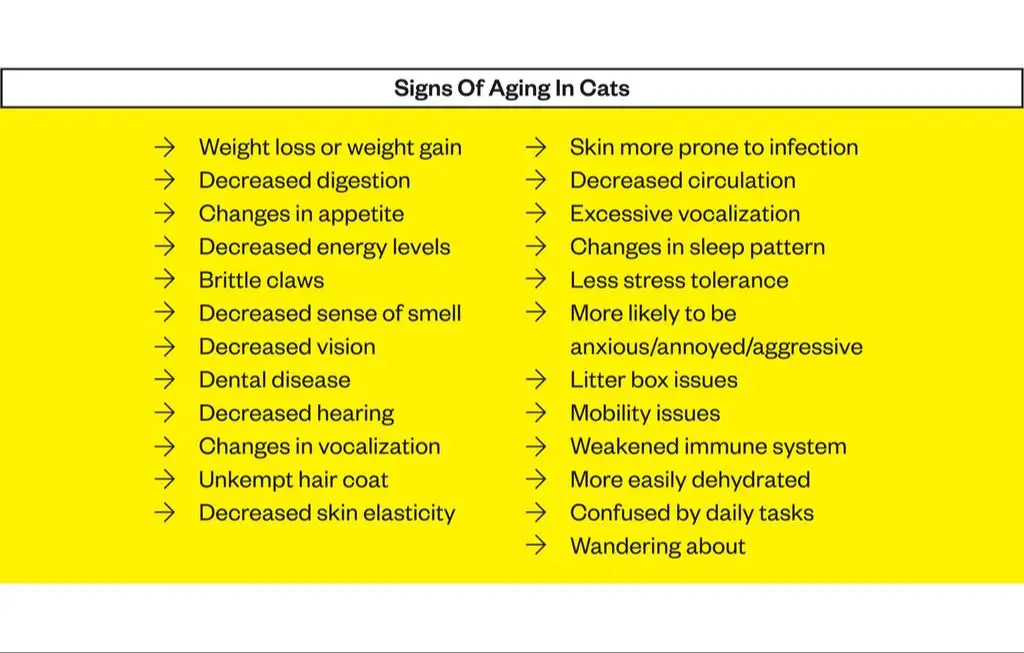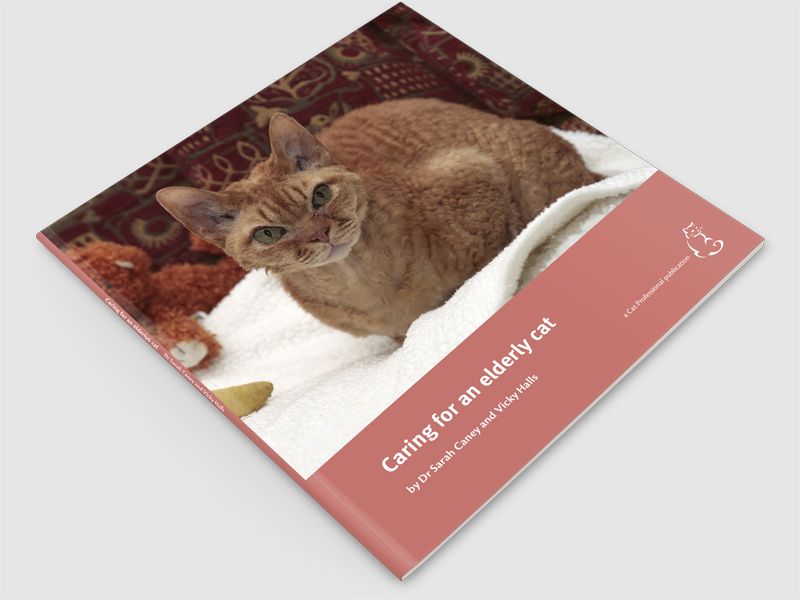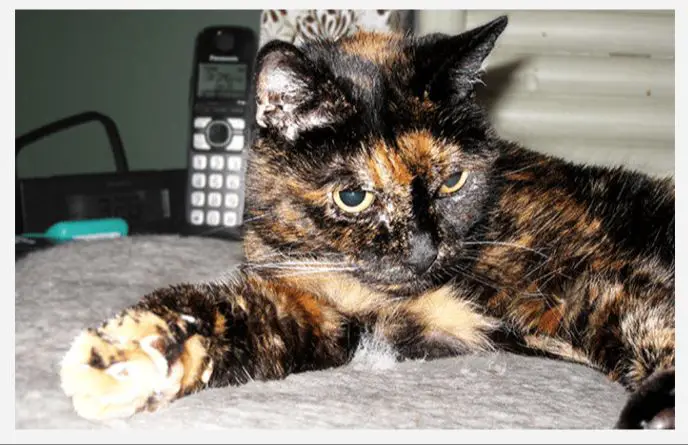The Graying Years
Cats have a reputation for having nine lives, but these furry felines do eventually grow old, just like humans. The average lifespan for an indoor cat is 15-20 years, though some cats live into their early 20s. For a cat, the “golden years” start around age 11. An old cat, sometimes affectionately called an “eldercat”, is generally over 15 years old.
According to the American Society for the Prevention of Cruelty to Animals (ASPCA), senior cats make up approximately 20% of the overall cat population. So those gray muzzles and slower gaits are quite common among our feline friends!
Common Terms for Old Cats
There are a few common terms used to describe an aging cat:
- Elderly cat – This term is generally used for cats over 10-12 years old. At this age, cats are considered senior and may start exhibiting signs of aging.
- Senior cat – A senior cat is typically over 7 years old. The senior stage starts around age 7-10 when cats begin transitioning into their golden years.
- Mature cat – A mature cat is generally between 3-6 years old. They are past the energetic kitten stage but still considered young adults.
While there are no definitive age ranges, in general “elderly” and “senior” refer to cats over 10 years old. “Mature” covers cats that are middle-aged. Understanding common terms for old cats helps identify when extra care and attention may be needed as they transition into their senior years.
Signs of Aging in Cats
As cats grow older, their bodies undergo changes just like humans do. Here are some of the most common signs of aging in cats:

Graying fur – Many cats start to develop gray hairs around their face and along their spine as they age. This is similar to graying hair in humans and is a normal sign of getting older.
Cloudy eyes – Aging cats often develop cloudiness in their eyes due to changes in the lenses and corneas. Their vision may become more blurred and limited.
Weight loss/gain – Metabolism changes as cats age, so they may gain or lose weight more easily. Monitoring your cat’s weight and adjusting their diet becomes important.
Decreased activity – Older cats tend to sleep more and be less active. They may have difficulty jumping up to high places and don’t play as much.
According to https://www.greatpetcare.com/wellness/10-signs-your-cat-is-getting-older/, other signs include bad breath, vocalization changes, and disorientation.
Caring for Elderly Cats
As cats age, their needs change and they require some adjustments to their care. Here are some tips for caring for elderly cats:
Diet: Senior cats may have dental issues or a decreased sense of smell and taste. Switch to soft, canned food or add water to dry kibble to make it easier to eat. Elderly cats also need extra hydration, so provide multiple water bowls around the home. Speak to your vet about senior cat food formulated with nutrients for joint health and digestion.

Litterbox: Older cats may have arthritis that makes climbing in and out of the litterbox painful. Use lower-sided boxes and place mats outside the box to make entry and exit easier. Keep the box very clean as senior cats are more likely to stop using a dirty box.
Exercise: Low-impact exercise like short walks and playing can help elderly cats stay limber. Adjust playtime for their decreased energy levels. Place ramps and steps around the home so they can easily reach beds and window perches.
Vet Visits: Take senior cats to the vet every 6 months for exams and bloodwork. Monitoring their health regularly is key for early detection of age-related diseases like kidney disease, hyperthyroidism, and cancer. Discuss supplements like glucosamine that support joint health.
Common Health Issues
As cats age, there are some common health issues that often arise. Three of the most prevalent are kidney disease, thyroid problems, and arthritis.1, 2
Kidney disease affects a large percentage of older cats. As the kidneys decline in function, cats cannot properly filter out waste products from their blood. This can lead to symptoms like increased thirst and urination, weight loss, vomiting, and more. Kidney disease is manageable if caught early through bloodwork screening and special diets.3
Hyperthyroidism is another very common issue, caused by an overactive thyroid gland producing excess hormones. This speeds up the metabolism, leading to symptoms like weight loss despite increased appetite, vomiting, increased activity or restlessness. Medication can help regulate thyroid levels.2
Arthritis causes stiffness, difficulty jumping, and pain. It can make movements like climbing stairs difficult. Joint supplements, anti-inflammatories, warm beds, and gentle exercise can help cats stay mobile and comfortable. Vets may prescribe pain medication if arthritis is severe.3
Keeping Cats Mentally Stimulated
As cats age, it’s important to keep their minds active and engaged. An elderly cat that is bored or unstimulated may experience behavior issues or declining cognitive abilities. Some ways to provide mental enrichment for senior cats include:
Food puzzles like treat balls or food mazes encourage cats to work for their food. This provides physical and mental exercise. Rotate different puzzle toys to keep cats engaged. Just be sure puzzles are appropriate for your cat’s mobility and dental health.
New toys like catnip mice, feather wands, laser pointers, or crinkle balls can pique a cat’s natural prey drive. Try hiding toys around the house and rotate them out to maintain novelty.
Changing up feeding routines, play times, and interactions prevents predictable routines. Senior cats can get stuck in habits so mix up schedules, food locations, and activities.
Allow access to new spaces like catios or screened porches for sensory stimulation. Supervise for safety.
Consider getting a second pet if appropriate. A friendly cat or dog companion provides social enrichment.
Tablets like Cat TV with videos for cats can provide visual, auditory and predatory stimulation when you’re away.
With some creativity and flexibility, you can keep your elderly feline mentally sharp and engaged in their golden years.
Quality of Life Considerations
As cats age, it’s important to monitor their quality of life and make adjustments to keep them comfortable and content. Some key things to watch for include:

Pain Levels – Look for signs of discomfort like decreased appetite, increased vocalizing, aggression, or changes in gait and mobility. Consult your vet about options for pain management. Cats are masters at hiding pain, so subtle changes may indicate a problem. According to one Reddit comment, you can ask your vet for tips on recognizing pain in elderly cats.
Mobility – Can your cat still easily get around, jump up on furniture, and access food/litter? Limit access to high perches or stairs if mobility is decreasing. Provide easy access ramps or limit confinement to one level of the home.
Appetite – Monitor if your cat is still enthusiastic about food or if consumption decreases. Try warming up wet food or hand feeding to stimulate appetite. Check teeth and treat any dental issues.
Beyond physical symptoms, pay attention to your cat’s overall demeanor. Do they still seek affection and engage in play? Are they still grooming? Focus on maintaining activities and environments that bring them comfort and joy. Adjust care as needed to prioritize quality of life. According to Cork’s Critter Care, good quality of life for senior cats revolves around enhancing comfort and reducing stress.
Saying Goodbye
One of the toughest decisions a cat owner has to make is knowing when it’s time to say goodbye to their beloved feline companion. There’s no definitive checklist, but signs like prolonged or chronic pain, incontinence, difficulty eating or moving around, and poor quality of life indicate euthanasia may need to be considered. You want your cat’s last days to be comfortable and free from suffering.
Many vets offer at-home euthanasia services to minimize stress and allow your cat to pass away peacefully at home. Your vet can explain the process and what to expect. Sedation is given first so your cat drifts into a deep sleep before the euthanasia solution is administered to stop the heart.
It’s normal to grieve the loss of a pet. Be patient with yourself and allow time to process the emotions. It may help to create a memorial, look at photos and share memories, or do something meaningful in your cat’s honor. Though painful, try to focus on the happy times. Your cat knew how cherished they were and had the best life because of your love.
Famous Long-Lived Cats
While the average lifespan for domestic cats ranges between 12-18 years, some felines have defied the odds and lived well into their 20s and even 30s. A few of the most famous record-holding cats include:

Nutmeg – This female tabby from the United Kingdom holds the Guinness World Record for the oldest cat ever at 38 years and 3 days old. She lived an incredibly long life spanning from 1968 to 2006.
Creme Puff – Previously holding the record before Nutmeg, this domestic shorthair lived an astounding 38 years and 3 days as well. Born in Austin, Texas in 1967, Creme Puff unfortunately passed away in 2005 just days after her 38th birthday.
Buttermilk – At the incredible age of 34 years, this Maine Coon male named Buttermilk was recognized as the oldest cat ever by the 2010 edition of Guinness World Records. Buttermilk was born in North Carolina in 1974 and lived over half his life with his owners before passing in 2008.
Corduroy – Certified as the oldest domestic cat ever by the Cat Fanciers’ Association, Corduroy reached the remarkable age of 27 years old. He was born in Oregon in 1968 and spent most of his long life as an only cat. Corduroy died in 1995 at age 27 years and 13 days.
Scooter – A Siamese cat owned by a couple in Mansfield, Texas, Scooter holds the record as the oldest living cat today at the age of 30 years old as of 2022. Now approaching his fourth decade of life, Scooter has far surpassed the typical Siamese lifespan of just 15-20 years.
Conclusion
As cats grow older, their needs change. Keeping an elderly cat comfortable, engaged, and healthy requires some adjustments by their caregivers. But with a little extra attention and minor modifications, senior cats can continue to lead happy and fulfilling lives.
The key is to monitor your aging cat closely. Look for any changes in behavior or health that may indicate an underlying issue. Address these promptly through vet visits, adjusting their environment, and tweaking care routines. Be proactive about managing conditions like arthritis or kidney disease through medication, diet and gentle exercise. Keep litter boxes clean and easy to access to accommodate changes in mobility or litter box habits.
Mentally stimulating activities, bonding through play and affection, access to sunny spots or cozy beds all help senior cats feel safe and engaged. Providing patience and understanding when behavioral issues arise can smooth the transition into their golden years. With some adjustments, our feline friends can continue lighting up our lives well into their senior years.
Eventually, declining health may necessitate difficult decisions about quality of life. Cherishing the special bond with a cat helps make that process meaningful. The memories of joyful years spent together will always remain.
